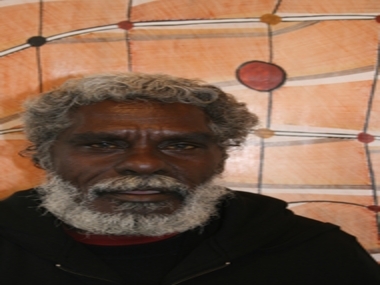MAWURNDJUL – ART AND POLITICS

John Mawrundjul in front the artwork commissioned for the Musee du quai Branly in Paris.
Posted by Jeremy Eccles | 28.04.09
Gallery: Drill Hall Gallery
Dates:
16.04.09
: 24.05.09
Location: ANU, Kingsley Street, Acton
A brief survey of the great Arnhemland artist, John Mawurndjul's work has been mounted in Canberra. It sits at the Drill Hall Gallery in the ANU until 24th May. The occasion was also used to launch a book of the papers from a symposium inspired by Mawurndjul's work, held at the Museum Tinguely in Basel in conjunction with the huge solo show of the artists work that toured Europe in 2005.
But the combination of 'Johnny's' (as he signs himself) luminous presence and this heavyweight appreciation has been used by local academics as the perfect opportunity to challenge the Government head on re aspects of its indigenous policies.
Let's start with the art, though. It begins with dynamic figurative barks from 1979, when Mawurndjul was about 27, then (unfortunately) jumps to the late 90s when complex figuration was still part of his armoury, but the delicate, intense rarrking that would come to form the basis of his big breakthrough into what balanda viewers call abstraction has almost taken over. This derived from his early experience of painting up the bodies of elders taking part in Mardayin ceremonies at the outstation where he was born, Mumeka – and where he still lives.
The central part of the exhibition – so much smaller than Swiss and German viewers saw that one seriously has to question Gallery policies in Australia that failed to bring the whole show home for us to see – reveals just how much variety Mawurndjul can achieve with three or four colours, many, many lines and a few circles. The infinite power of his country is thrillingly apparent.
But his beautifully balanced life on that remote country is under threat, according to Jon Altman and Luke Taylor from the ANU. “Today, at a time when the Australian state is promulgating a discourse of failure in Indigenous affairs, and focusing more and more on normalisation, Mawurndjul's art stands out as a beacon to fundamentally challenge these public policy perspectives”, they write in the feisty Drill Hall catalogue.
They get more specific too: “The NT Intervention and subsequent 'Closing the Gap' policy arguably have the ultimate aim of normalising all Indigenous people in remote communities and enforcing cultural transformations. In August 2007, the former Prime Minister stated that 'while respecting the special place of indigenous people in the history and life of this country, their future can only be as part of the mainstream of the Australian community'. This is the new orthodoxy that remains dominant today”.
“But the art of John Mawurndjul demonstrates something that directly challenges this view. It shows that Aboriginal people can engage with the mainstream and the highly competitive global art market on their own terms. There is no 'frozen culture' (as Amanda Vanstone once dismissed outstation art) in Mawurndjul's art practice, it is dynamic, adaptive and transformative art charged with the inspiration of being on country in remote Arnhem Land”.
And that dynamism is surely more than evidenced by the seriousness with which ten European curators and academics took the man's art when they talked about the aesthetics, museology, politics and even the neuropsychology of it over two days in 2005. Their rich thoughts are now published by the Aboriginal Studies Press in a volume called 'Between Indigenous Australia and Europe: John Mawurndjul', edited by Claus Volkenandt and Christian Kaufmann, and selling for $45.
URL: info.anu.edu.au/mac/drill_hall_gallery
Share this:
»  del.icio.us
»
del.icio.us
»  Digg it
»
Digg it
»  reddit
»
reddit
»  Google
»
Google
»  StumbleUpon
»
StumbleUpon
»  Technorati
»
Technorati
»  Facebook
Facebook
Contact Details
Gallery: Drill Hall Gallery
Contact: Dr Terence Maloon
Email: dhg@anu.edu.au
Telephone: +61 2 6125 5832
Address: Kingsley Street Acton 2601 ACT
Gallery: Drill Hall Gallery
Contact: Dr Terence Maloon
Email: dhg@anu.edu.au
Telephone: +61 2 6125 5832
Address: Kingsley Street Acton 2601 ACT
Where is the exhibition?
Further Research
Gallery: Drill Hall Gallery
Artists: John Mawurndjul
News Tags: Drill Hall Gallery | Intervention | John Mawurndjul | Jon Altman | Maningrida | Museum Tinguely
News Categories: Australia
Exhibition Archive
- 10.10.17 | TARNANTHI 2017
- 11.08.17 | Natsiaas 2017
- 20.07.17 | APY ART DOMINATES THE WYNNE
- 17.07.17 | Anangu Artist Wins $100,000 Prize
- 14.07.17 | The End of AAMU
- 11.07.17 | ART ACROSS THE COUNTRY
- 11.07.17 | TARNANTHI IN OCTOBER
- 05.07.17 | TJUNGUṈUTJA - from having come together
- 13.06.17 | Ghost-Nets Straddle the World
- 07.06.17 | Grayson Perry Going Indigenous?
- 05.06.17 | Barks Bigger than Ben Hur
- 27.05.17 | NGA QUINQUENNIAL 2017
- 21.05.17 | Blak Douglas Finds Home at the NGA
- 21.05.17 | BRIAN ROBINSON WINS HAZELHURST WOP
- 18.05.17 | PARRTJIMA 2.0
Advertising

